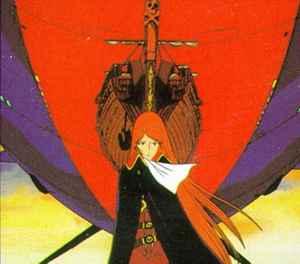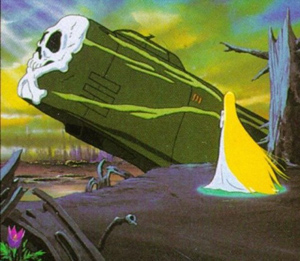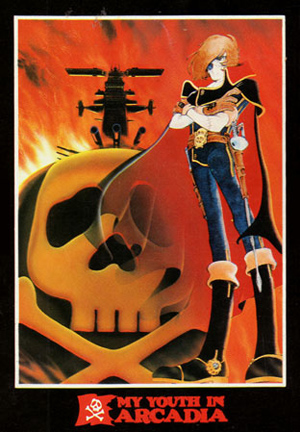 If you’ve been collecting anime for a while or been around folks who have, you may have heard about a character known as Captain Harlock (or Herlock, depending on the romanization). A strong-willed space pirate with a heart of gold, this character has been a bit of an anime icon for decades, appearing in various works penned by creator Leiji Matsumoto (Galaxy Express 999, Space Battleship Yamato). The film Arcadia of My Youth looks to a background story of sorts for our hero, which we’ll talk about here.
If you’ve been collecting anime for a while or been around folks who have, you may have heard about a character known as Captain Harlock (or Herlock, depending on the romanization). A strong-willed space pirate with a heart of gold, this character has been a bit of an anime icon for decades, appearing in various works penned by creator Leiji Matsumoto (Galaxy Express 999, Space Battleship Yamato). The film Arcadia of My Youth looks to a background story of sorts for our hero, which we’ll talk about here.
Released in 1982, the movie starts with early 20th Century aerial explorer Phantom F. Harlock in his single-engine plane over a mountain range in New Guinea. Suddenly he encounters the ghostly Owen Stanley Witch of the mountains (who looks awfully similar to those twins in Matrix Reloaded). The ghost laughs at Harlock’s inability to fly over a very high peak so he dumps nearly all of his fuel to fly off toward the mountain and into (his own) history book.
We flash forward to the future, in which Captain Harlock is losing a battle against The Illumidus, an alien race who has conquered the Earth. At a local base, Harlock meets with alien Supreme Commander Zeda and Zoll, a mercenary from Tokarga (a race the Illumidus have previously conquered.) Zeda shows respect for Harlock’s military record and has his second-in-command Murgison offer him a job, which Harlock promptly rejects. He’s given some food coupons and brusquely told he’ll never fly again.
 At dinner, Harlock meets a bespectacled man who he winds up helping in a bar room brawl against some Illumidus officers. The man introduces himself as Tochiro, as Harlock notes he’s wearing an Earth military uniform similar to his own. Soon they’re captured by Zoll and put under a mind scanner to see if they’ve been working on any resistance activities. Instead, the scanner detects something very odd about the pair. It turns out their ancestors shared a similar experience centuries ago during World War II, and Zoll’s machine plays out the incident for them (and the audience) to see.
At dinner, Harlock meets a bespectacled man who he winds up helping in a bar room brawl against some Illumidus officers. The man introduces himself as Tochiro, as Harlock notes he’s wearing an Earth military uniform similar to his own. Soon they’re captured by Zoll and put under a mind scanner to see if they’ve been working on any resistance activities. Instead, the scanner detects something very odd about the pair. It turns out their ancestors shared a similar experience centuries ago during World War II, and Zoll’s machine plays out the incident for them (and the audience) to see.
Later, Harlock and Tochiro are discussing their ancestors when Zeda and Prime Minister Triter, a human liaison with the Illumidas, approach and ask to speak to Harlock. They want him to transport a volunteer army to the conquered planet Tokarga and destroy it since it’s no longer of any value to the Illumidus. Meanwhile, Tochiro goes to investigate a dirigible-styled spacecraft, which has crashed some distance away. There he meets Emeraldas, a free space trader who ran across a flaming nebula that nearly destroyed her ship. So Tochiro decides to see what he can do to help her out. While this is going on, the Illumidus’s communications officer Mime goes to visit Zoll and his fellow mercenaries at dinner, where she tells of Zeda’s destructive order…
Eventually, Harlock meets up with the Voice of Free Arcadia, a female speaker who gives messages of hope to the hapless humans on Earth. This encounter becomes one of the most painful moments of his life, but it leads to him gaining a new sense of purpose, new friends, and even a new battleship from the unlikeliest of places.
 In turn, this movie led to me remembering the qualities which got me into anime in the first place: strong archetypal heroes, deep stories, painted (and sometimes detailed) artwork and great action sequences. No bloody-nose boobie-shots panty-shots-punch-schmuck-across-the-screen jokes needed. We have people who recognize their friends are precious to them, humanity’s morale is low, and tyranny rules the Earth, and so they set out to start correcting the injustices, living free and doing so with honor.
In turn, this movie led to me remembering the qualities which got me into anime in the first place: strong archetypal heroes, deep stories, painted (and sometimes detailed) artwork and great action sequences. No bloody-nose boobie-shots panty-shots-punch-schmuck-across-the-screen jokes needed. We have people who recognize their friends are precious to them, humanity’s morale is low, and tyranny rules the Earth, and so they set out to start correcting the injustices, living free and doing so with honor.
One might say there are a couple of issues with the screenplay wherein things happen with no real explanation, such as the building of Harlock’s ship or the events following his meeting with the Voice of Free Arcadia. However, director Katsumata Tomoharu moves things along fairly well throughout the film. Overall themes of sacrifice, duty, hope, and a bit of reincarnation supersede logic sometimes, but that’s cool too.
I first saw an edited version of this film entitled Vengeance of the Space Pirate on VHS in the late ’80s and have acquired better versions of the film as the years have gone by. The last version released on R1 DVD by AnimEigo is the best presentation of Arcadia of My Youth. The colors have never been bolder or sharper in any other release to date. There’s only one disappointing aspect, though, coming from the final climactic ship-to-ship battle between Harlock and Zeda. The outside scenes are done in very heavy contrast and can be difficult to follow sometimes. I was hoping the DVD restoration crew would brighten this scene to sharpen shapes in certain sequences, but this didn’t happen. Nevertheless, the picture on this disc is a great testament to how good older Matsumoto-influenced material can look when effort is put into a modern release.
 The audio is my only real concern, since I had to turn up the volume about 20% higher than my old VHS version. There was also a faint analog hiss in the background. Still, the dialogue, music and foley came in pretty well and, considering the extra materials on the disc, this was a minor grievance. Some may object to the languages available since only Japanese audio is present with no English dub option. However, since the only English material available is the marginal performance on the My Youth In Arcadia release (or the heavily edited Vengeance of the Space Pirate), this is no real big loss.
The audio is my only real concern, since I had to turn up the volume about 20% higher than my old VHS version. There was also a faint analog hiss in the background. Still, the dialogue, music and foley came in pretty well and, considering the extra materials on the disc, this was a minor grievance. Some may object to the languages available since only Japanese audio is present with no English dub option. However, since the only English material available is the marginal performance on the My Youth In Arcadia release (or the heavily edited Vengeance of the Space Pirate), this is no real big loss.
When I first grabbed this DVD, I decided to rifle through the extras before watching the film. There’s a set of trailers, which include the Japanese ones for the film. Now even though they mostly contain footage not actually in the movie, the trailers are still pretty cool to watch. Then there are the 3 separate filmographies for the seiyuu, creator Leiji Matsumoto, and the movie’s main character, Captain Harlock. After that I checked out the unusual facts gallery, which contains a ton of info. One thing to enjoy as an anime fan is any opportunity to learn about the history of this medium and the chance to discuss it with fellow enthusiasts. AnimEigo’s crew does a good job of giving us stuff to talk about on this DVD.
However, the license has since lapsed and there’s been no announcement of a new distributor for this excellent film as of the time of this writing. It’s highly recommended that you track this movie down at your local convention or various retail sites. Since it’s out of print, I’ve seen collector-type prices range from $35 to $80, so eventually you should be able to find a copy.

